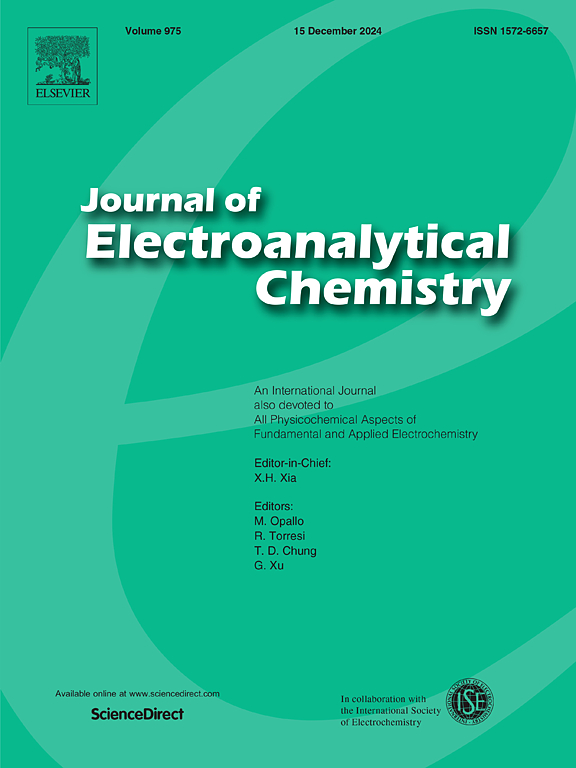电化学阻抗谱法用于考古钱币非侵入性研究的新方法
IF 4.1
3区 化学
Q1 CHEMISTRY, ANALYTICAL
引用次数: 0
摘要
考古学上的铜制硬币通常被绝缘铜绿层覆盖,这阻止了有效电接触的建立。这阻碍了电化学技术的使用,包括电化学阻抗谱,因为铜绿的不希望去除不可逆转地损坏了工件。为了克服这一点以及传统样本带来的其他限制,我们设计了两种新颖的实验方法。在第一种方法中,电接触问题是通过利用激光烧蚀的独特能力来解决的,它可以产生一个足够深的微洞,可以到达下面的合金,并且足够小,肉眼看不见。在微孔中插入石墨微纤维获得了所需的电接触。按照该领域的最佳实践,将凝胶电解质压在硬币的反面,并包含参考电极和反电极,从而完成三电极电池。第二种方法是完全非侵入性的,它利用了一种对称的四电极电池设计,这种设计以前从未应用于文化遗产。对称电池是通过将硬币的每一面与凝胶电解质接触来实现的,凝胶电解质包含一个参考电极和一个工作/反电极。本文参照文献中提出的实验设置,对每种方法在真实考古样品上得到的结果进行了比较和深入的讨论。这两种新方法都能够实现高质量数据和非侵入性水平的前所未有的结合。此外,初步数据拟合表明,在低频区多孔介质中的扩散现象起作用。本文章由计算机程序翻译,如有差异,请以英文原文为准。

Novel methods for the non-invasive study of archaeological coins with electrochemical impedance spectroscopy
Archaeological copper-based coins are usually covered by insulating patina layers, which prevent the establishment of effective electrical contacts. This hinders the use of electrochemical techniques, including the electrochemical impedance spectroscopy, as the undesirable removal of the patina irreversibly damages the artifacts. To overcome this and other constrains imposed by Heritage samples, we designed two novel experimental approaches.
In the first approach, the electrical contact problem is solved by exploiting the unique capabilities of laser ablation in producing a micro-dig that is deep enough to reach the underlying alloy, and small enough to be invisible to the naked eye. The insertion of graphite micro-fibres in the micro-dig granted the required electrical contact. Following the best practice in the field, the three-electrode cell was completed by a gel electrolyte pressed against the opposite side of the coin and containing reference and counter electrodes.
The second approach is completely non-invasive and exploits a symmetric four-electrode cell design that has never been applied to Cultural Heritage objects before. The symmetric cell was realised by putting each side of the coin in contact with a gel electrolyte, containing a reference and a working/counter electrode.
In this paper, the results obtained on real archaeological samples with each approach are compared and thoroughly discussed, with reference to experimental setups proposed in literature. Both novel approaches were able to achieve an unprecedented combination of high-quality data and non-invasiveness level. In addition, preliminary data fitting suggested a role for a diffusion phenomenon in porous media in the low-frequency regime.
求助全文
通过发布文献求助,成功后即可免费获取论文全文。
去求助
来源期刊
CiteScore
7.80
自引率
6.70%
发文量
912
审稿时长
2.4 months
期刊介绍:
The Journal of Electroanalytical Chemistry is the foremost international journal devoted to the interdisciplinary subject of electrochemistry in all its aspects, theoretical as well as applied.
Electrochemistry is a wide ranging area that is in a state of continuous evolution. Rather than compiling a long list of topics covered by the Journal, the editors would like to draw particular attention to the key issues of novelty, topicality and quality. Papers should present new and interesting electrochemical science in a way that is accessible to the reader. The presentation and discussion should be at a level that is consistent with the international status of the Journal. Reports describing the application of well-established techniques to problems that are essentially technical will not be accepted. Similarly, papers that report observations but fail to provide adequate interpretation will be rejected by the Editors. Papers dealing with technical electrochemistry should be submitted to other specialist journals unless the authors can show that their work provides substantially new insights into electrochemical processes.

 求助内容:
求助内容: 应助结果提醒方式:
应助结果提醒方式:


